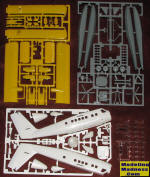
| KIT #: | PK-127 (40127) |
| PRICE: | $7.00 from a vendor |
| DECALS: | Two options |
| REVIEWER: | Scott Van Aken |
| NOTES: |

| HISTORY |
The de Havilland Canada DHC-6 Twin Otter is a Canadian 19-passenger STOL (Short Takeoff and Landing) utility aircraft developed by de Havilland Canada and currently produced by Viking Air. The aircraft's fixed tricycle undercarriage, STOL abilities and high rate of climb have made it a successful cargo, regional passenger airliner and MEDEVAC aircraft. In addition, the Twin Otter has been popular with commercial skydiving operations, and is used by the United States Army Parachute Team and the United States Air Force's 98th Flying Training Squadron.
| THE KIT |
 It
still surprises me how popular Matchbox kits are with modelers. Despite no
longer tooling new kits by the end of the 1970s, the brand was moved to
China where kits continued to be produced. By the late 1980s, the plastic
portion was purchased by Revell AG who continued to release kits under the
Matchbox name, this kit being a 1989 boxing. Any more, the kits are produced
under the Revell label.
It
still surprises me how popular Matchbox kits are with modelers. Despite no
longer tooling new kits by the end of the 1970s, the brand was moved to
China where kits continued to be produced. By the late 1980s, the plastic
portion was purchased by Revell AG who continued to release kits under the
Matchbox name, this kit being a 1989 boxing. Any more, the kits are produced
under the Revell label.
Despite being a Revell AG kit, this one is still in the three different colors of plastic of this series of kits. The various shades of plastic were very much a trademark of Matchbox kits and it is a bit of a shame that we have lost that. Typical of the brand, this kit is accurate in outline, but lacking in the sort of detail one now expects. This is particularly true of the interior, which is little more than a cockpit floor, rear cockpit bulkhead, two generic seats a rather thick control yoke and an instrument panel. There is no cabin detail aside from a rear bulkhead and I think that is for stiffness. All the side windows are inserted into openings in each fuselage half and so will be difficult to mask. They are designed to be installed from the inside.
Once the fuselage halves are together, one then attaches the nose. Two options are provided here, one being longer than the other to provide additional baggage space. You'll need to add 20grams of weight to this, to keep it from tail sitting.
Wings are upper and lower halves with three piece engine nacelles. If one wants the props to turn, those must be attached when the forward nacelle piece is glued on. All the under wing flap hinges are separate pieces as are the upper wing fences. Landing gear is actually quite sturdy for the main gear and the nose gear is a single piece with the gear and wheel molded as one. Matchbox designed the kit to be either on wheels, skis or, for the adventurous, floats. All these bits are included in the kit, with additional stabilizing fins for the horizontal stab included if doing the float version.
Instructions are quite typical of Matchbox
and are well drawn. Painting details are at the end of the c onstruction
diagrams. Color and markings are on the back of the box with two options
provided. One is the box art plane with the CAF in yellow with red bits.
This options can be built on skis. The other is also mostly yellow with a
large red fuselage band and black trim which will both need to be painted, a
task made more difficult by the wing struts and closeness of the engines.
Decals look to be fairly nicely done, though I noticed that the maple leaf
in the CAF option were a bit out of register. Fortunately, there have been
both military and civil decals printed over the years so you have other
markings options should you decide to go that route.
onstruction
diagrams. Color and markings are on the back of the box with two options
provided. One is the box art plane with the CAF in yellow with red bits.
This options can be built on skis. The other is also mostly yellow with a
large red fuselage band and black trim which will both need to be painted, a
task made more difficult by the wing struts and closeness of the engines.
Decals look to be fairly nicely done, though I noticed that the maple leaf
in the CAF option were a bit out of register. Fortunately, there have been
both military and civil decals printed over the years so you have other
markings options should you decide to go that route.
| CONCLUSIONS |
While the number of interesting subject only kitted by Matchbox has been whittled away over the years, to my knowledge, the Twotter is not one of them. It makes into a very nice model, despite the lack of cabin and is well worth taking the time to build.
| REFERENCES |
https://en.wikipedia.org/wiki/De_Havilland_Canada_DHC-6_Twin_Otter
February 2016
Copyright ModelingMadness.com
Thanks to me for the preview kit.
If you would like your product reviewed fairly and fairly quickly, please contact the editor or see other details in the Note to Contributors.